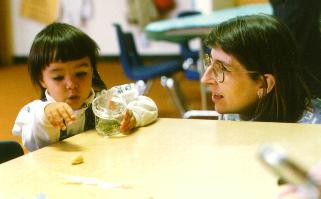
Sensory stimulation provides a child with a wide range of auditory (hearing), tactile (feeling), visual (seeing), olfactory (smelling), and tasting experiences. As the child performs these activities, the goal of the teacher is to provide active verbal exchange with him/her. The main objective of sensory stimulation time is to increase the oral language of the children, enabling them to describe themselves and their environment effectively. An example of this would be in describing a piece of spaghetti. The teacher could point out that the spaghetti is hard, smooth, long, cylindrical, and brittle as the children feel and break dry spaghetti. Each activity listed in this section is classified by the sense that it is to stimulate. Note also that besides the explanation of the activity and the list of materials needed, the vocabulary to be developed is listed. Try to use these words (and as many others as you can add) as you and the children experience sensory stimulation and talk about it. A few examples are listed below.
Flower Smell (Olfactory) 
Materials Needed - A fresh cut rose, carnation, chrysanthemum, hyacinth, tulip, daffodil, violet, lilac. Place flowers in water to keep them fresh.
Vocabulary - Distinctive, fragrant, perfumy, delightful, sweet, ambrosial, pleasant, heavy, mild, rose, carnation, chrysanthemum, hyacinth, violet, tulip, daffodil, lilac, dull, spring, strong.
Relate the book The Plant Sitter by Gene Zion (Book #59 in Children's Literature section) to this activity.
Flashlight Fun (Visual)
Holiday Ideas: At Halloween, Thanksgiving, Christmas, Easter, and other special holidays, seasonal pictures instead of animal pictures could be used.
Materials Needed - Flashlights, seasonal pictures, animal, toy, or clothing pictures.
Grape Day (Tasting)
Vocabulary - Chewy, gummy, juicy, sweet, delicious, tangy, flavorful, light, cold, crisp, tart, grape, dark, luscious, mild, savory, delicate.
Zoo Animal Sounds (Auditory)
If the children are unable to match the sound of an animal with its name, do not let them keep guessing incorrectly. Instead, as you listen to a sound, hold up the picture that represents the animal making the sound and say, "This is the sound of an elephant trumpeting."
Materials Needed - A tape or record (available at local libraries) of zoo animal sounds and pictures that correspond to the animal that produces the sound on the tape.
Vocabulary - Roar, bellow, squeal, squeak, grunt, whistle, growl, trumpet, hiss, buzz, swish, wheeze, croak, snarl, bark, howl, yowl, squawk, shriek, screech.
Say: "You were able to tell the animal because you listened to the sound. You heard the (roar or whatever). You used your ears to hear the sounds."
Wet and Dry (Tactile)
Materials Needed - Like objects that differ only in one being wet and the other dry. This could include: dried and cooked spaghetti or other noodles, dried flowers and fresh cut or growing flowers, dried peas and fresh or frozen peas, dried and fresh leaves, a potato chip and mashed potatoes, cookie dough and a baked cookie, wet or moist clay and hardened clay. There should be enough containers and plates for each item, napkins and plastic aprons for the children for easy clean up since this is a tactile activity and children will be touching the items. Bake extra cookies for the children, and tell the children that since the items will be touched it would be best not to eat any of the food, but that afterwards they could eat the extra cookies.
Vocabulary - Brittle, hard, pliable, squishy, gooey, wet, dry, moist, crunchy, stiff, pliant, impliable, bending, soft, supple, rigid, petrified, willowy, flexible, unbending, firm, unyielding, stiff, malleable.